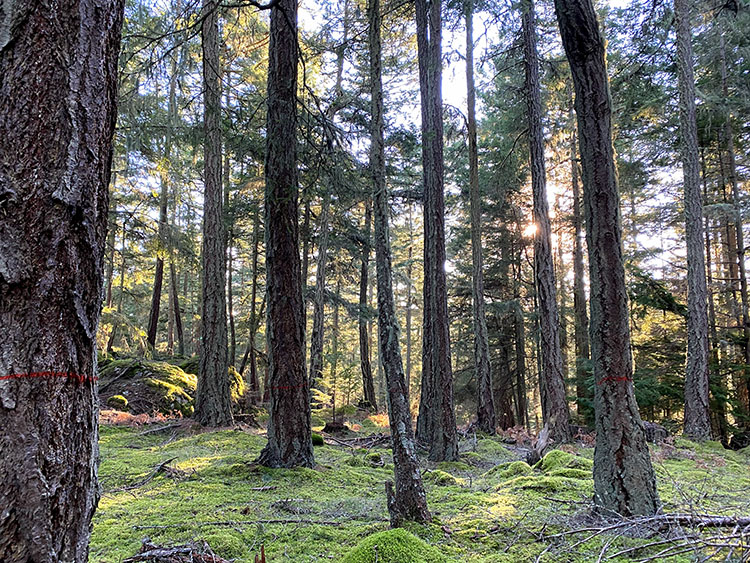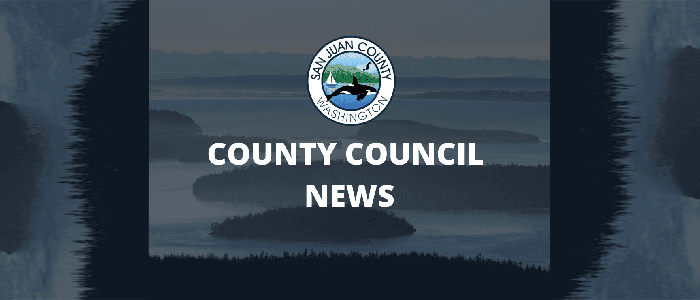||| FROM BRENT LYLES, EXECUTIVE DIRECTOR, FRIENDS OF THE SAN JUANS |||
Judging by construction activity and real estate transactions, the pressures and speed of development in San Juan County have never been greater. Fortunately, the County’s Comprehensive Plan, or Comp Plan, can be a key tool for managing growth and protecting our County’s rural character. Right now, citizen interest is growing in how this tool can best ensure that sensible, science-based planning and environmental stewardship guide the growth and development in our County.
During the Comp Plan update process, the County can change the designation, or zoning, of land. Right now, the County is currently considering opening up 127 acres of protected forest lands to allow for more intense development. The parcels in question are currently zoned as Forest Resource Lands, but the County’s Planning Commission recently voted to preliminarily recommend changing these parcels to the Rural Farm Forest designation. This Rural Farm Forest zoning would allow more development on these currently forested lands, such as vacation rentals and non-forestry commercial uses, and it would triple the allowance for impervious surface on the properties.

A San Juan County forest. Photo: Rainshadow Consulting
In San Juan County, protecting our existing Natural Resource Lands, including both Forest Resource Lands and Agricultural Resource Lands, is critically important. Natural Resource Lands support our local farmers and foresters, preserve our rural character, and have benefits like protecting air and water quality, aiding aquifer recharge, providing access to recreational activities, sequestering carbon, and improving wildlife habitat and connectivity. This protection can be achieved right now during the Comp Plan update process.
In response to this opening up of protected forest lands to development, citizens are mobilizing to oppose this decision through efforts like Friends of the San Juans’ Comp Plan Action Team. Both at the Planning Commission and County Council meetings, our community has the opportunity to weigh in on whether opening up these Forest Resource Lands to more intense development makes the most sense for environmental stewardship, climate resilience, and preserving the rural character of our island communities.
In addition to the Comp Plan’s importance for guiding how and where development unfolds in the San Juan Islands over the next 20 years, it also lays the groundwork for the County’s response to the climate crisis. To their credit, the County’s Community Development staff have done an admirable job in making climate-forward recommendations to the Planning Commission on certain environmental issues in the Comp Plan update. For example, newly proposed language in the Comp Plan update includes recommendations for a County-wide climate change impact study, energy-efficiency upgrades, and climate mitigation in a variety of contexts.
But strong climate action requires strong voices from our community, monitoring and engaging in the process to make sure our County’s climate response is aggressive and bold; climate action should be a requirement, not just a recommendation. Through the Comp Plan Action Team and other initiatives, Friends of the San Juans is joining with other organizations and community efforts, encouraging San Juan County’s citizens to engage effectively in the Comp Plan update process, both to address the current explosion of development and to put climate response and climate resiliency front and center.
For information about the Comp Plan Action Team’s monthly Zoom meetings, email Brent Lyles at brent@sanjuans.org. For more resources about engaging in the Comp Plan, visit sanjuans.org/sjc_comp_plan.
**If you are reading theOrcasonian for free, thank your fellow islanders. If you would like to support theOrcasonian CLICK HERE to set your modestly-priced, voluntary subscription. Otherwise, no worries; we’re happy to share with you.**









Thanks for this heads up, Brent.
I oppose increasing the development potential in our islands for many reasons.
The “build-out” potential for our county is already northwards of 100,000 people.
These proposed changes would make the “build-out” potential much higher.
Imagine the difficulties of getting a ferry reservation when the population is 5 to 6 times higher than the current level.
Thank you Brent. Input from the community is definitely needed in all areas of the comp plan review. The Planning Commission did recommend re-designating some parcels from Forest Resource to Rural Farm-Forest, however, they also recommended NOT increasing the density on those parcels–this will require vigilance by the community because future docket requests are likely to ask for density increases on those and other parcels.
My hope for the future is to have a Climate and Environment office within county government headed by an elected official responsible to the electorate. A Climate and Environment office would have one just mission, unlike the Department of Community Development who, in my opinion, for all their many skills and talents, are stretched quite thin juggling multiple responsibilities such as long-range planning, issuing building permits, doing building inspections, reviewing land-use designations and docket requests, issuing vacation rental permits, providing shoreline and critical area protections, enforcing a myriad of regulations and plenty more.
Thank you for the work the Friends do.
A few points:
Wasn’t the forest resource land designation intended to protect timber growth and harvesting?
Timber farming hasn’t been commercially viable here for many years.
Is tho statement accurate? “This Rural Farm Forest zoning would allow more development on these currently forested lands, such as vacation rentals and non-forestry commercial uses, and it would triple the allowance for impervious surface on the properties.“ Wouldn’t it also permit affordable housing projects? Less expensive land for homes?
Janet–I’ve never seen a build-out analysis for the County. Did the County contract for it?
Every time I hear another tree fall, my first thought is: Where are the birds going to live?
Janet, the beauty of all of this is that the ferry is the limiting factor. If you reduce the ferry trips or boat sizes, or increase the fare, you get fewer visitors. If you increase ferries, you get more visitors. The ferry is the aorta of the island. All Orcas needs to do is adjust the ferry to keep the on-island population exactly where you want it. No fancy ordinances or zoning changes or land buys or votes needed. Just have the island notify WSF of a desire for fewer boats and islanders can easily reserve all the available slots so that visitors and tourists get shut out.
“I’ve never seen a build-out analysis for the County. Did the County contract for it?”
Basic 101 planning. Such a study should have been done many years ago.
Our population and summer carrying capacity are already “resource limited” by the shaky ferry system. Never mind the water supply, which becomes scarce in the dry months of July and August. The idea that these islands can support 100,000 people is sheer lunacy. A quarter of that is probably closer to the truth.
Peg–regarding the “buildout analysis,” there may be some confusion of terms. I think Janet is referring to the County’s Land Capacity Analysis, which you’re familiar with as part of the Comp Plan process, which projects a theoretical development potential of 100,000+ population under current zoning. A “Land Capacity
Analysis,” requested by Island Stewards and others would assess the EFFECTS of achieving that capacity on resource use such as water, energy use, services, traffic, etc. This has not been done.
‘Planning’ for future growth must start with ‘do no harm’ (do no further harm) to the environment. I highly recommend the book OVERSTORY. Here is one line from the book: “Deforestation: a bigger changer of climate than all of transportation put together. Twice as much carbon in the falling forests than in all the atmosphere.”
Planning must include replacement of one+ tree for everyone that is felled. Just one simple step to environmental sanity.